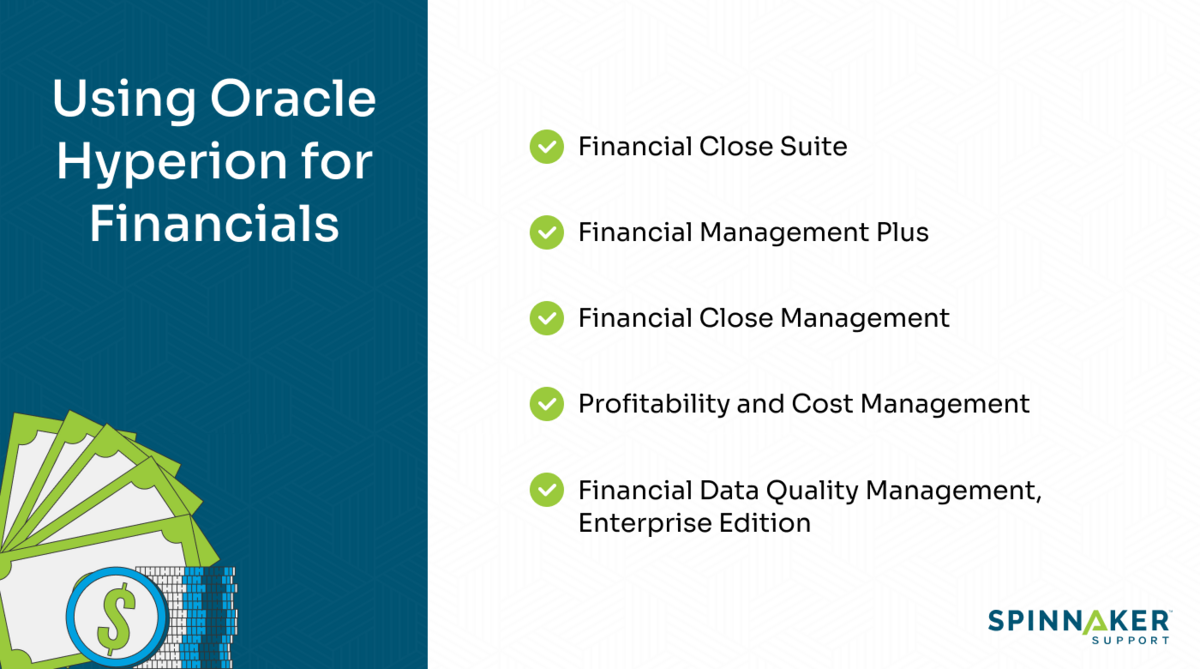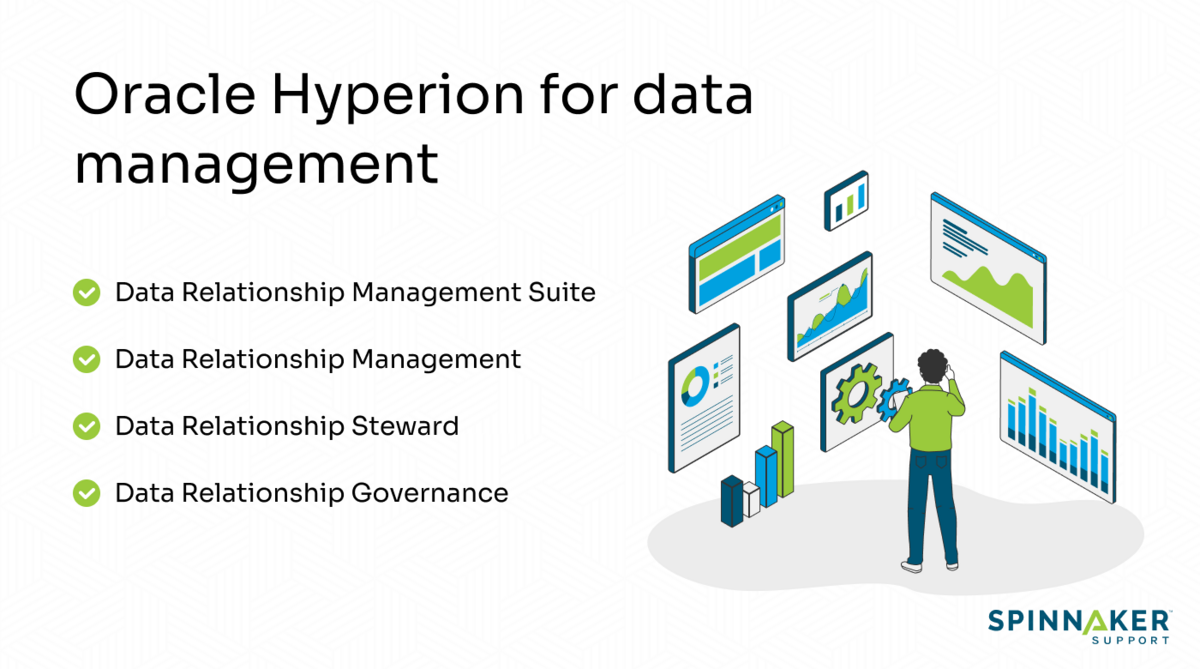As organizations grow and expand, the complexity of managing financial and operational data across multiple systems and entities can become overwhelming. Siloed data, inconsistent processes, and lack of visibility can hinder effective decision-making and impede growth.
Oracle Hyperion provides a suite of tools designed specifically for financial management and business planning. In a world where only 30% of businesses understand the full impact of their financial decisions, it seeks to allow organizations to take control of their financial processes and make confident data-driven decisions.
In this article, we’ll explore what Oracle Hyperion means for how you handle budgeting, planning, financial consolidation, and reporting, ultimately leading to improved efficiency and better business outcomes.
What is Oracle Hyperion?
Oracle Hyperion is an enterprise performance management (EPM) suite designed for financial management and business planning. It caters to medium and large enterprises with complex financial reporting needs, offering tools for budgeting, planning, consolidation, and reporting.
Hyperion integrates with various ERP systems and data sources, centralizing financial data for comprehensive analysis. This integration capability allows organizations to consolidate financial information from disparate systems, providing a unified view of their financial standing.
As part of Oracle’s EPM portfolio, Hyperion contributes to the company’s leading 23% market share in the EPM segment. Other offerings in this portfolio include Oracle Planning and Budgeting Cloud Service and Oracle Enterprise Performance Reporting Cloud Service.
Hyperion’s functionality extends beyond basic financial reporting. It provides advanced features for financial consolidation, allowing organizations to combine financial results from multiple entities. Its planning and budgeting tools enable detailed financial projections and scenario analysis.
While Oracle no longer sells Hyperion as a new product, the company continues to support existing installations. This support includes regular updates to maintain system functionality and address evolving business requirements, ensuring that current Hyperion users can continue to rely on the system for their financial management needs.
Key capabilities of Oracle Hyperion
Hyperion comprises several modules that handle specific functions. Insights from one module can inform processes in another, creating a cohesive system for financial management.
This interconnectedness, along with the suite’s comprehensive nature, explains why many organizations continue to use Hyperion, even as Oracle shifts its focus to cloud-based EPM solutions.
The core capabilities of Hyperion are as follows:
1. Financial planning and management
Oracle Hyperion’s financial planning and management features are organized into several key modules, each addressing specific financial management needs.

The Financial Close Suite provides modules for financial consolidation, close, and statutory reporting. This suite helps organizations efficiently manage their financial close processes and meet various reporting requirements.
Financial Management Plus is a financial consolidation and reporting application built with advanced Web technology. Designed for use by the finance team, it reduces reliance on IT maintenance services. This module allows financial managers to quickly close and report financial results, meet global regulatory requirements, and reduce compliance costs. It supports informed decision-making by providing reliable financial data.
Financial Close Management helps companies define, execute, and report on financial close period activities. It offers centralized monitoring of close process tasks, providing an automated, repeatable system of record. This centralization can reduce time and effort required for financial close activities, while improving accuracy and consistency.
Profitability and Cost Management provides insights into cost and profitability. This module aims to improve business performance by identifying cost and profitability drivers, giving users visibility and flexibility, and helping align resources. Detailed information on factors affecting profitability enables organizations to make informed decisions about resource allocation and strategic initiatives.
Financial Data Quality Management, Enterprise Edition allows business analysts to develop standardized financial data management processes and validate data from any source system. This is valuable in complex business environments where financial data often comes from multiple systems and sources. The module’s focus on data quality and consistency helps reduce costs and complexity in financial data management processes.
2. Operational planning
Oracle Hyperion Planning Plus integrates financial and operational planning processes in a centralized platform. Users can access the system through Microsoft Excel or a web interface, accommodating different work preferences and potentially reducing training needs.
The connection allows users to analyze how operational decisions impact financial outcomes, create more accurate forecasts by incorporating operational data, and identify areas where operational changes could improve financial performance.
Hyperion Planning Plus also centralizes planning data, enabling consistent use of data and assumptions across departments, reduction of discrepancies in plans and forecasts, and improved collaboration between financial and operational teams.
Organizations can use this tool to develop more comprehensive budgets that reflect operational realities, create scenarios to test the financial impact of operational changes, and align operational plans with financial goals and constraints.
3. Data quality and relationship management
Hyperion’s data quality and relationship management features address a significant issue in financial management: the impact of poor data quality on revenue. Over half of companies report that at least 25% of their revenue is affected by poor data quality. These features aim to improve data accuracy and consistency across an organization.

The Data Relationship Management Suite helps enterprises master, govern, and analyze enterprise dimensions, alternate hierarchies, and related attributes. It aligns how a business operates with how it measures its performance. This suite delivers referential integrity by mastering dimensions across transactional and analytical applications, whether Oracle or third-party, on-premise or in the cloud.
Data Relationship Management serves as a foundation for business applications. It helps organizations curate, master, and govern enterprise dimensions, hierarchies, and reporting attributes across operational and analytical silos. This approach enables reconciled, consistent, accurate, and trustworthy reporting and business analytics.
The Data Relationship Steward module allows licensed users to manage, administer, and secure master data within the Oracle Data Relationship Management repository. This aligns with the role of a data steward in organizations, who manages the consistency, quality, and integrity of master reference data sets across enterprise information systems.
The Data Relationship Governance module enables licensed users to participate in master data change management and remediation workflows. Users who need to submit, enrich, approve, commit, or be notified of requests within the Oracle Data Relationship Governance application must have licensed access to this module.
Is Oracle Hyperion still relevant?
Oracle Hyperion is still relevant for many organizations, especially those with active implementations. While Oracle is pushing Oracle Cloud EPM as a more modern approach to enterprise performance management, existing Hyperion customers can continue using their current systems. This allows them to maintain their established processes and workflows without immediate pressure to migrate.
Oracle continues to actively support and update Hyperion applications, releasing new updates to meet the financial management needs of existing customers. After all, many companies still rely on Hyperion for business-critical finance functions, including closing books, planning, forecasting, and reporting.

If you’re worried about Oracle’s priorities, you should consider switching to third-party support from a partner like Spinnaker Support. These services typically support all release versions of Hyperion and cover most product areas within the suite. Organizations getting third-party support for Hyperion through Spinnaker Support reduce their support costs by an average of 62%.
One key advantage of third-party support is the ability to maintain on-premises deployments indefinitely, without pressure to upgrade or migrate to cloud solutions. These services also aim to help organizations maintain regulatory compliance and security for their Hyperion systems.
In addition to standard support, Spinnaker Support also offers supplementary services such as break/fix support, archiving solutions, and technical advisory. These services can help organizations maximize the value of their existing Hyperion implementations while potentially reducing overall support expenses.
Oracle Hyperion FAQ
If you still have some lingering questions about Hyperion, here are some answers that might help:
What is the latest version of Oracle Hyperion?
The latest version of Oracle Hyperion is 11.2, released in 2019. Despite its age, this version remains actively supported by Oracle, receiving regular updates to address evolving business requirements.
If your company is still using Hyperion 11.2, you can either continue to rely on Oracle’s support and maintenance services or switch to third-party support to ensure your EPM system stays current and effective in meeting your financial management needs.
What is Oracle Hyperion used for?
Oracle Hyperion is used for financial management and reporting tasks. It enables detailed budgeting, planning, and forecasting, allowing organizations to create financial projections and what-if scenarios. It also automates financial consolidation and close processes across multiple entities, streamlining statement preparation.
It facilitates account reconciliation by matching transactions and balances, and supports tax reporting with features for tax provisions and country-by-country reports. The system produces customized financial and management reports with drill-down capabilities.
Additionally, Hyperion serves as a centralized platform for financial data management, integrating information from various ERP systems and other sources into a single repository, providing a unified view of financial data across the business.
Does Oracle still sell Hyperion?
Oracle doesn’t sell Hyperion anymore, focusing instead on its cloud-based EPM solutions, primarily Oracle Cloud EPM. However, the company continues to support existing Hyperion installations. This means current users can maintain their systems either through vendor or third-party support, as Oracle directs new customers towards its more recent EPM offerings.
Is Hyperion an ERP or CRM?
Hyperion is neither an ERP nor a CRM system. Instead, it’s classified as an EPM (enterprise performance management) solution.
Unlike CRM (customer relationship management) systems, which manage customer interactions and relationships, or ERP (enterprise resource planning) systems, which integrate core business processes like finance, HR, and supply chain, Hyperion focuses specifically on financial planning, reporting, and analysis tasks within an organization.
That said, Hyperion can integrate with ERP and CRM systems, pulling financial data from them into a unified platform.
Take charge of your financials with Oracle Hyperion and Spinnaker Support
Oracle Hyperion is an Enterprise Performance Management (EPM) solution that specializes in enterprise finance. It offers a comprehensive suite of applications designed for financial planning and management, data quality and relationship management, and operational planning. These tools enable organizations to streamline their financial processes and gain deeper insights into their performance.
While Oracle no longer sells Hyperion as a new product, the company continues to provide support for active installations. This ensures that organizations with existing Hyperion implementations can maintain their systems and continue to leverage its capabilities.
For those looking to maximize their Hyperion investment, third-party Oracle support services are available from partners like Spinnaker Support. These alternatives often offer significant cost savings compared to standard Oracle support, along with tailored services that can be customized to meet specific organizational needs.
As you consider the future of your Hyperion implementation or explore options for enterprise financial management, it’s important to evaluate all available support and maintenance strategies. These choices can significantly impact the longevity and effectiveness of your EPM system.
For more information on how to maximize your Hyperion investment or to discuss support options, contact the team at Spinnaker Support!

